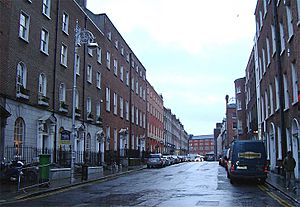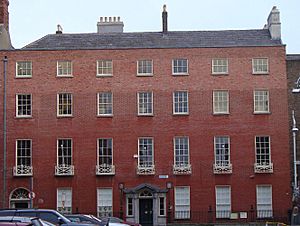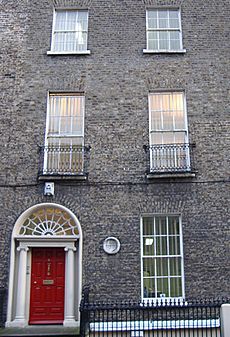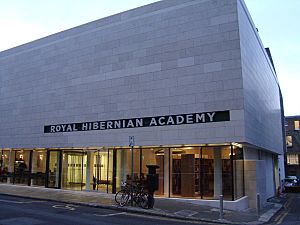Ely Place, Dublin facts for kids
| Plás Íle (Irish) | |
 |
|
| Former name(s) | Hume Row |
|---|---|
| Namesake | Henry Loftus, 1st Earl of Ely |
| Length | 200 m (700 ft) |
| Width | 17 metres (56 ft) |
| Location | Dublin, Ireland |
| Postal code | D02 |
| Coordinates | 53°20′15″N 6°15′15″W / 53.337391°N 6.254196°W |
| southwest end | dead end |
| northeast end | Merrion Street Upper, Merrion Row, Baggot Street Lower |
| Other | |
| Known for | Royal Hibernian Academy |
Ely Place is a famous street in the heart of Dublin, Ireland. It's known for its beautiful old buildings, built in the Georgian style. You can find it where Upper Merrion Street, Lower Baggot Street, and Merrion Row all come together. It also connects to St Stephen's Green, a well-known park in the city.
History of Ely Place
Ely Place was first planned out in 1768. A few years later, in 1773, it was even called "Hume Row" on maps. The first houses built on the street were at the north end (numbers 2-4). These were built in the 1970s in a style that looked like the old Georgian buildings.
The very first house to be built on this street was Ely House, which is now numbers 7 and 8. It was built in 1771 by Gustavus Hume. Later, in 1776, a banker named John La Touche lived there. A famous artist who worked with plaster, Michael Stapleton, decorated the inside of this house. He created beautiful designs for Mrs. La Touche's dining rooms.
Ely House later became the home of the Countess of Ely, Frances Monroe. She was married to Henry Loftus, the first Earl of Ely. After her husband passed away, Lady Ely continued to live in the house for 40 more years. At one point, Sir William Thornley Stoker, whose brother was the famous writer Bram Stoker, owned the house. The Knights of Saint Columbanus, a Catholic organization, bought Ely House in 1922 and made it their main office.
Right next door, at number 6, lived the Countess of Clare, Anne Whaley. She was married to John Fitzgibbon, who was a very important judge in Ireland. The Countess of Clare also hired Michael Stapleton to decorate her home. Both countesses were famous for their grand houses and the big parties they hosted. Their homes are still known for their amazing plasterwork.
In 1859, houses number 5 and 6 became government offices. They were used by the General Valuation and Boundary Survey of Ireland. This is where Sir Richard Griffith finished his huge project of valuing all the land and buildings in Ireland. This work became known as the "Griffith Valuation." The Valuation Office stayed in these buildings for 138 years, until 1998. Today, an advertising company called Ogilvy & Mather uses the building.
Another well-known person who lived on Ely Place was John Philpot Curran. He was a lawyer and a very witty speaker. He defended the United Irishmen, who wanted Ireland to be independent. His daughter was even in love with Robert Emmet, another famous Irish rebel. John Philpot Curran lived at number 12 (now number 4) from 1780 to 1807.
The original house at number 3 was once the Queen's Service Academy. This school, started in 1852, helped students prepare for important exams. These exams were for jobs in the British Army, the government (called the Civil Service), the police (the Royal Irish Constabulary), and for becoming lawyers. A later headmaster of the school was Dr. William John Chetwode Crawley, who was a writer and historian.
Ely Place Upper
Ely Place Upper is a part of Ely Place that continues further south. It has a row of five houses that were built in 1828. On maps from 1837, this area was called "Smith's buildings" after the builder, Thomas Smith. He lived in number 1 from 1836 to 1849.
In the 1890s, number 3 Ely Place Upper was the home of Frederick and Annie Dick. Their house became a meeting place for the Theosophical Society, a group interested in spiritual ideas. Famous writers like W. B. Yeats, Maud Gonne, and George Russell used to visit there.
The writer George Moore lived at number 4 at the start of the 1900s. He once had a funny argument with his neighbors about the color he painted his front door!
On the other side of the street lived Oliver St. John Gogarty. He was a writer, a surgeon, and known for his sharp wit. The Royal Hibernian Academy later took over his house.
Building Developments
Around 1970, a property developer named Matt Gallagher wanted to build a large new art gallery for the Royal Hibernian Academy (RHA). He offered to build it, and the RHA happily accepted. Work began in 1972. The RHA's old building, which was a Victorian house once owned by Oliver St. John Gogarty, was taken down. The new modern building was designed by Raymond McGrath. Everyone expected it to be ready for its first art show in 1975.
However, Matt Gallagher sadly passed away in January 1974. His son, Patrick Gallagher, took over the family business. Within a few months, all work on the building stopped. For many years, the building site was used to store materials for other projects. Around 2002, the old building was finally fixed up and now looks as it does today.
Many of the buildings on Ely Place are now used as offices. The Irish National Parks and Wildlife Service department, which helps protect Ireland's nature, has its office on this street.






